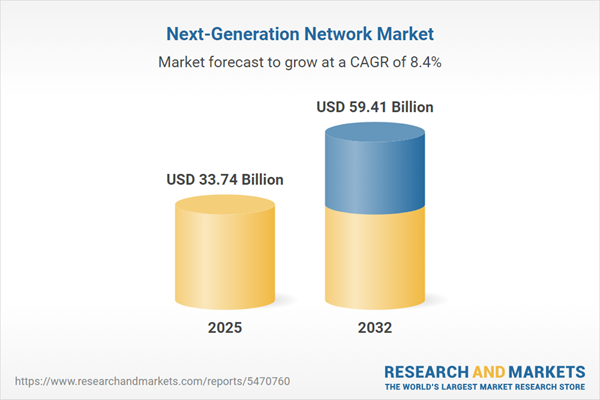Speak directly to the analyst to clarify any post sales queries you may have.
Next-generation network solutions are reshaping how enterprises achieve secure, agile, and resilient connectivity across global operations. For enterprise leaders navigating digital transformation, understanding the current network landscape is vital for maintaining agility and long-term competitiveness.
Market Snapshot: Next-Generation Network Market Outlook
The next-generation network market demonstrates robust worldwide momentum, driven by enterprise initiatives focused on digital modernization. Organizations are steadily replacing aging infrastructure with digital-first systems to enable responsive operations and future-focused IT capabilities. The market is expected to grow from USD 31.11 billion in 2024 to USD 33.74 billion in 2025, reaching USD 59.41 billion by 2032, with a projected compound annual growth rate of 8.42%.
The primary drivers include rising enterprise demand for enhanced network performance across hybrid and distributed architectures. Decision-makers are prioritizing investments in secure, flexible platforms to enhance customer experience, increase operational efficiency, and remain adaptable amid unpredictable industry shifts.Scope & Segmentation: Next-Generation Network Market
A clear understanding of market segmentation allows executives to develop effective procurement strategies and align technology investments with organizational goals. The next-generation network market spans several critical dimensions:
- Deployment Models: Hybrid, private, and public architectures address diverse enterprise needs for scalability, risk reduction, and regulatory compliance.
- End Users: Mobile-driven professionals and organizations in banking, healthcare, government, manufacturing, and telecommunications require specialized network solutions that adhere to sector-specific security and compliance standards.
- Technologies: Adoption of 4G LTE, 5G, Network Functions Virtualization (NFV), and Software-Defined Networking (SDN) propels automation and efficiency, allowing rapid deployment of new services across complex environments.
- Applications: Enterprise mobile broadband, IoT connectivity, and mission-critical workloads with low-latency or high-availability requirements form key use cases for next-generation network platforms.
- Components: Core technologies such as 5Gc and EPC, management systems including EMS and OSS, and diverse access methods like fiber optics and microwave underpin the scalability and adaptability needed for digital transformation.
- Regional Coverage: The Americas, EMEA, and Asia-Pacific regions each face distinct regulatory and economic environments, shaping network deployment and integration practices within local industries.
- Leading Providers: Companies such as Cisco Systems, Huawei, Nokia, Ericsson, Juniper Networks, Ciena, ZTE, Hewlett Packard Enterprise, Dell Technologies, and Fujitsu are instrumental in advancing best practices and continuously innovating market solutions.
Key Takeaways: Strategic Trends in the Next-Generation Network Market
- Software-defined and virtualized architectures provide flexibility, enabling rapid adaptation to operational changes and evolving market demands.
- Edge computing and network slicing deliver real-time performance, which empowers enterprises to scale distributed operations efficiently while supporting emerging digital applications.
- Incorporating artificial intelligence and machine learning transforms network management, facilitating predictive analytics and automation for stronger reliability and proactive issue resolution.
- Implementing open standards with modular hardware streamlines technology integration, protects prior investments, and supports systems built to handle future needs.
- Regional trends are shaping market priorities; Asia-Pacific continues to expand network deployment, while infrastructure modernization and compliance remain central for EMEA and the Americas.
- Strategic collaboration among vendors and research institutions strengthens security, promotes scalability, and ensures regulatory alignment in response to shifting enterprise priorities.
Tariff Impact: U.S. Trade Policy and Network Supply Chains
Recent U.S. tariffs affecting network and semiconductor products are prompting companies to reassess their global supply chains. Many enterprises are diversifying procurement, sourcing more from Southeast Asia, India, and Mexico to manage supply risks. The shift includes a greater emphasis on modular and software-defined upgrades, reinforced by adoption of open standards to reduce supply chain vulnerabilities. Transparent procurement and new strategic partnerships have become essential for compliance and resilience in the context of changing geopolitical pressures.
Methodology & Data Sources
This report leverages data gathered from technical whitepapers, regulatory bodies, industry expert panels, and confidential participant sources. Cross-verification and scenario-driven analysis underpin the accuracy and real-world relevance of all findings.
Why This Report Matters
- Enables senior decision-makers to benchmark strategies and make informed investments rooted in emerging trends and best practices for next-generation networking.
- Clarifies the impact of regulation and global supply chain developments on enterprise procurement and infrastructure investment decisions.
- Delivers actionable recommendations to guide organizational resilience, adaptability, and long-term stability in a rapidly changing environment.
Conclusion
Embracing modular, secure network strategies enables organizations to remain responsive and innovative in dynamic markets. Strategic investment in next-generation solutions strengthens business continuity and supports ongoing digital transformation.
Additional Product Information:
- Purchase of this report includes 1 year online access with quarterly updates.
- This report can be updated on request. Please contact our Customer Experience team using the Ask a Question widget on our website.
Table of Contents
3. Executive Summary
4. Market Overview
7. Cumulative Impact of Artificial Intelligence 2025
Companies Mentioned
The companies profiled in this Next-Generation Network market report include:- Cisco Systems, Inc.
- Huawei Investment & Holding Co., Ltd.
- Nokia Corporation
- Telefonaktiebolaget LM Ericsson
- Juniper Networks, Inc.
- Ciena Corporation
- ZTE Corporation
- Hewlett Packard Enterprise Company
- Dell Technologies Inc.
- Fujitsu Limited
Table Information
| Report Attribute | Details |
|---|---|
| No. of Pages | 196 |
| Published | November 2025 |
| Forecast Period | 2025 - 2032 |
| Estimated Market Value ( USD | $ 33.74 Billion |
| Forecasted Market Value ( USD | $ 59.41 Billion |
| Compound Annual Growth Rate | 8.4% |
| Regions Covered | Global |
| No. of Companies Mentioned | 11 |









